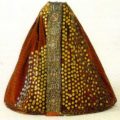 Recreation of fringe trim, seen on two different beaded or brakteat’d altar frontals in the Halberstadt Dom Museum (Piece 1 | Piece 2) and at Lüne Abbey.
Recreation of fringe trim, seen on two different beaded or brakteat’d altar frontals in the Halberstadt Dom Museum (Piece 1 | Piece 2) and at Lüne Abbey.
I came up with two different methods, each resulting in identical results, matching exactly what is seen on the photos, desite poor image quality.
For proof of concept I used the fiber I have on hand, pearl cotton, then used a finer floche embroidery cotton (two ply floss), instead of the period silk.
Each method uses three warp threads, the woven has a fourth for fringe length.
The “knotted” method uses cut lengths of doubled fiber, woven around the warp threads in a inverse U shape, and then through itself.
The “woven” uses one more warp thread, offset to one side, to pass around for fringe length. The woven one works a bit faster, as the knotted requires use of a fine hook or longer needle to push, pull and prod the fiber through the base threads.
Neither requires a actual loom for short lengths, though an inkle loom might be nice to have for the woven one as it seems to be a natural choice for longer lengths.
I did both with a long needle. In the case of the woven samples I tried both a needle with long lengths of thread, and a makeshift bobbin/shuttle to weave through the base threads, using the needle to manuever and compact the working thread. Starting/working in a new thread was easy. Just one more thread to wrap around on the next pass.




























